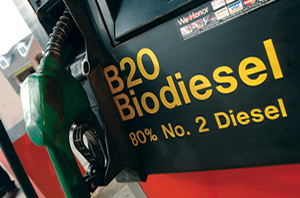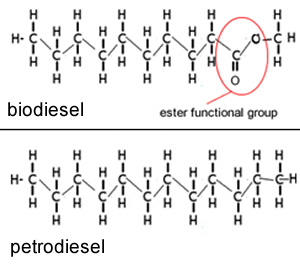
Petroleum diesel, or petro-diesel, as it is sometimes referred to, is produced from crude oil in a process called fractional distillation. A mixture of carbon chains between 8 and 10 carbon atoms in length is produced.
Biodiesel, like petrodiesel, is made from long chain hydrocarbons, the difference being that the hydrocarbons used to form biodiesel come from reneweable plant or animal oil. Oil undergoes a process called transesterification where the fatty acids of the oil are converted into compounds generally known as methyl esters.
Both petrodiesel and biodiesel are not pure substances as the hydrocarbons that form each fuel vary in size.
When petrodiesel and biodiesel burn in excess oxygen they produce carbon dioxide and water. Incomplete combustion, which occurs when oxygen is presented in limited proportions, produces carbon monoxide which is toxic.
One of the most challenging issues facing us today is that of Global Warming. Anthropogenic climate change and its link to fossil fuels is undeniable. Green house gases, such as carbon dioxide and even water are products of the combustion reactions of biodiesel and petrodiesel.

Some of the properties of each fuel are listed below.

1) Balance the following combustion reactions
a) C12H 26(l) + O2(g) => H2O(g) + CO2(g)
b) C11H 22O2 (l) + O2(g) => H2O(g) + CO2(g)
c) Which reaction above represents the combustion of a methyl ester?
2) With reference to the molecular structure of both petrodiesel and biodiesel state why incomplete combustion is less of a problem for biodiesel than it is for petrodiesel.
3) Write the balanced equation for the incomplete combustion of methane in oxygen. States not required.
4) With reference to intermolecular bonding explain why a sample of biodiesel is more likely to be found as a solid at low temperatures than a sample of petrodiesel?
5) Explain how fractional distillation works to separate crude oil into usable fractions.
6) With reference to intermolecular bonding explain why biodiesel is more viscous than petrodiesel?
7) Why is energy content of diesel is measured in kJ/g as opposed to kJ/mol?
8) Biodiesel is produced from plant oil. Are saturated hydrocarbons likely to be found in petrodiesel or biodiesel? Explain.
9) Consider the following molecules. A - CH3(CH2)6CH3 , B- CH3(CH2)6COOH
, C- CH3CHCH(CH2)3CH3 D- CH3(CH2)6COOCH3
i. Which molecule is likely to be found in a sample of biodiesel? Explain
i. Which molecule is likely to be found in a sample of petrodiesel? Explain
iii. Which molecule is likely to form one of the reactants in the formation of biodiesel? Explain
v. Write a chemical equation for the formation of biodiesel using the reactant in iii. above.